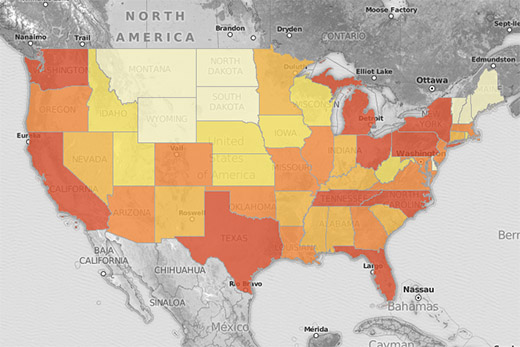A new model called HepVu reports estimates of hepatitis C virus (HCV) infection in every US state for persons over 18 years old. Developed by researchers at Emory University's Rollins School of Public Health and the Centers for Disease Control and Prevention (CDC), the new statistical model integrates several publicly-available data sources and includes a map showing HCV infections in each state. HCV infection is the most common blood-borne infection in the United States and can lead to liver failure, liver cancer, and/or death.
Led by Eli Rosenberg, PhD, an epidemiologist and assistant professor at Rollins School of Public Health, the research team combined data from the National Health and Nutrition Examination Survey (NHANES), death records from the National Vital Statistics System, U.S. Census intercensal data and the 2010 U.S. Census to discover local patterns and provide the first comprehensive state estimates of both past or current HCV and chronic HCV infection in the United States.
The researchers showed that although nationally 1.67 percent of adults in 2010 had past or current HCV infection, this varied substantially by state. The West census region had the highest regional rate, with 10 out of 13 states having rates above the national average. In contrast, the Midwest had the lowest region-specific rate of 1.14 percent. The South had the largest number of persons with HCV (1,157,400).
Complete findings are available in a new publication in the April 2017 issue of Clinical Infectious Diseases,
"Hepatitis C infection is a major source of liver-related illness and death in our country yet until now, we haven't able to see the full picture of which areas are most-impacted," explains Rosenberg. "In the absence of a comprehensive national HCV surveillance system, we and our CDC colleagues took the next-best approach by synthesizing vast quantities of publicly-available data to estimate HCV infection at the state-level. These findings can be regularly updated as new data become available. These numbers will be helpful to guide policies, resources, and practices aimed at lowering the burden of HCV infection in all US states."
Fast Facts
- Using a single and consistent approach, researchers estimated the prevalence of hepatitis C among non-institutionalized adults in all 50 U.S. States and the District of Columbia.
- Consistent and comparable state-level estimates of hepatitis C prevalence can help health departments and local prevention programs with their planning and use of resources.
- The West Census Region had the highest prevalence of HCV antibody at 2.14%, with 10 of 13 states in the West Region having a prevalence higher than the national average.

